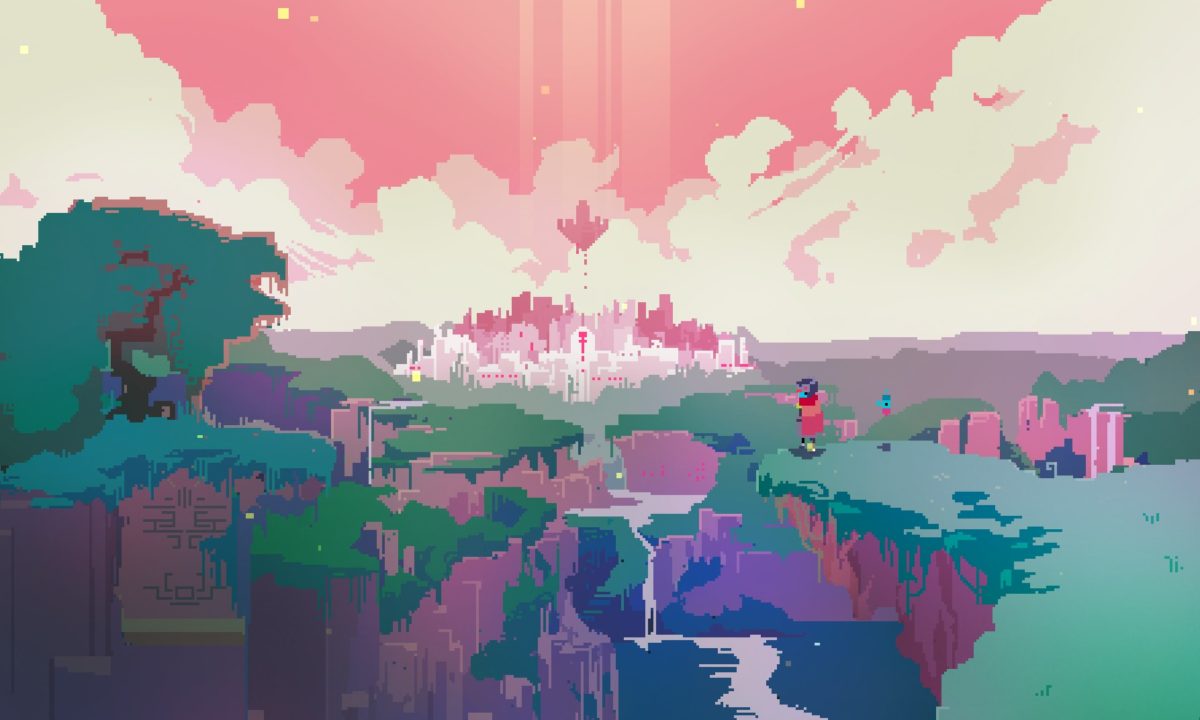Recently, I played and completed Hyper Light Drifter, Journey, and Abzu. Weeks after finishing the final game in this set, I realized that I’d just explored three different games with one very large factor in common: each use a silent narrative. “What? No words?! Is there even a story?!” Of course there’s a story, you lovable goof! In the case of games with silent narratives, players are (at most) given music, visuals, and gameplay to piece together what might be going on. While this can seem like a recent trend on the landscape of video games, silent narratives in media date back to the late 1800s with silent movies. Of course, silent movies were designed by necessity rather than preference – which makes a silent narrative that much more compelling in the modern age of entertainment. To explore how these experiences left their mark on me, let’s take a look at what made each one stand out.
Hyper Light Drifter – A Visually Loud Silent Narrative
The art of Hyper Light Drifter leaves a lot to the imagination. This silent narrative feels like walking through an art gallery where each painting progresses a tale from where the previous one left off. As the player moves through what seem to be abandoned battlegrounds and ruins, the game tells the story of its world one masterpiece frame at a time. Glimpses into the past are provided as we come across the corpses of titan-sized beings and leftover artillery. Clearly, a war occurred. Which side would my character have been on? Who was victorious? What was being battled over? My brain continued to grind through questions such as these throughout my experience.

Hyper Light Drifter also provides character development with visual cues. Throughout the game, we are given clues that tell us more about our hero, the Drifter. Upon reaching certain checkpoints, the Drifter will suddenly cough up blood and movement speed is slowed dramatically for a short period of time. Although it’s a brief moment, it exists so that we never forget how vulnerable the Drifter actually is despite constant growth and progress. The final touch comes into play when we’re low on health. The Drifter begins to bleed, leaving a trail of blood in his wake as he fights to survive on the brink of defeat. This serves as both a storytelling component, and as a way for the player to be reminded that a health pack must be found soon.
Journey – An Environmentally Silent Narrative
Environment design (commonly called Level design) is a powerful tool for a silent narrative. Journey is a game which wastes no time showing the player where they need to go. Just as the player loads into the world, they’re presented with a brightly lit mountain off in the distance. Instantly, we’re sure that this is our objective. Rather than the usual arrow that some games provide as a guide; the size and appearance of it makes this obvious. This mountain can certainly speak for itself. Almost as if it silently beckons, “come to me – I’m huge and mysterious!”

During the first few areas of the game, I noticed another cloaked figure gliding around just as I was. At first, I figured that the game spawned a computer controlled friend for me. Soon, I realized that this was actually another player entirely. With no direct way to communicate beyond the animations and movements we can perform with our avatars, my new partner and I naturally began guiding one another on our quest to the mountain. We had no reason to help each other. Yet, there we were, making it a point to stay together for as long as possible. Journey leads you through sprawling, cavern-like locations, so the feeling of loneliness is abundant. I still recall these cooperative moments with awe. Seeing someone else on my quest brought comfort, and I held on to that comfort tightly as I continued forward.
Abzu – An Audibly Soaked Silent Narrative
Shortly after I completed Journey, Abzu was released. This timing was serendipitous, as both games share a creator – Matt Nava. In this spiritual successor, many of the same elements are used to help players understand the story. Instead of Journey’s real-life companions, we’re given a plethora of underwater wildlife with which to interact. For example, the player can take hold of a manta ray and enjoy the ride or in a few cases, befriend a larger fish so that it can clear a path for us. Regardless, it would seem that most of the ocean’s inhabitants are on our side and anything unnatural is not. Throughout the latter half of the game, the player comes across odd, alien-looking metal triangles. While most creatures of the sea welcome the player’s approach, these triangles quickly teach us to maintain a safe distance – lest we wish to be violently electrocuted.

While Abzu is a feast for the eyes, sound design is what makes this silent narrative truly stand out from the others. A fully orchestrated score controls the mood for each area, and the lifelike noises of the wildlife provides all the context we’d ever need. Each camera movement works in perfect unison with the pacing of the soundtrack. Schools of fish are introduced with playful flute sections, and tremendous whales provide their own orchestra with their stunningly accurate undersea howls. I don’t think I’ve ever felt tinier in a video game than when Abzu put me next to one of these whales. If you ever get around to it, I recommend that Abzu be enjoyed in a dimly lit room with your favorite headphones.
As high-tech tools, like virtual reality, are becoming more commonplace, it’s encouraging that game designers are finding new applications for methods that are over 200 years old. While it’s great for a tale to be laid out, there’s something special about an experience that makes players interpret the story for themselves. What’s a silently narrated game that you found memorable?
